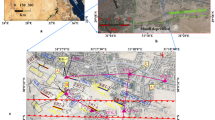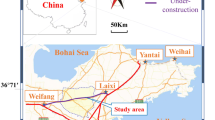Abstract
Various geological disasters can easily occur in tunnels that pass through a limestone stratum. The fine detection of the karst system is significant for safe construction. In this paper, a progressive integrated geophysical method is proposed for fine detection of the karst area of an urban subway. The method combines ground-penetrating radar (GPR), transient electromagnetics (TEM), cross-hole electrical resistivity tomography (ERT), and 3D laser scanning to provide quantitative and integrated detection imaging in a shallow karst system. First, 3D images of reflected waves and the apparent resistivity in the study area are determined using GPR and TEM methods, and the key development of abnormal karst bodies along the mileage direction is delineated. Meanwhile, the TEM slice combination results intuitively show the low-resistance anomaly's distribution and development direction. The main water channel is inferred within the detection range. Second, cross-hole ERT exploration is performed to realize the type of judgment and accurate positioning of karst caves. Finally, 3D laser scanning is conducted to obtain the 3D spatial orientation and size of the large-scale caves identified or those that could have a large influence on metro tunnel construction. Geophysical survey results provide a reference for the design and parameter selection of the cave grouting treatment scheme. This method has been effectively applied in a shield section of the R1 line of the Jinan Metro.










Similar content being viewed by others
References
Al-fares, W., Bakalowicz, M., Guérin, R., & Dukhan, M. (2002). Analysis of the karst aquifer structure of the Lamalou area (Hérault, France) with ground penetrating radar. Journal of Applied Geophysics, 51(2–4), 97–106.
Anbazhagan, P., Rohit, D., Prabhakaran, A., & Vidyaranya, B. (2018). Identification of karstic features in lateritic soil by an integrated geophysical approach. Pure and Applied Geophysics, 175(12), 4515–4536.
Belfer, I., Bruner, I., Keydar, S., Kravtsov, A., & Landa, E. (1998). Detection of shallow objects using refracted and diffracted seismic waves. Journal of Applied Geophysics, 38(3), 155–168.
Benson, A. K. (1995). Applications of ground penetrating radar in assessing some geological hazards: Examples of groundwater contamination, faults, cavities. Journal of Applied Geophysics, 33(1–3), 177–193.
Beres, M., Luetscher, M., & Olivier, R. (2001). Integration of ground-penetrating radar and microgravimetric methods to map shallow caves. Journal of Applied Geophysics, 46(4), 249–262.
Braitenberg, C., Sampietro, D., Pivetta, T., Zuliani, D., Barbagallo, A., & Fabris, P. (2016). Gravity for detecting caves: Airborne and terrestrial simulations based on a comprehensive karstic cave benchmark. Pure and Applied Geophysics, 173(4), 1243–1264.
Butler, D. K. (1984). Microgravimetric and gravity gradient techniques for detection of subsurface cavities. Geophysic, 49(7), 1084–1096.
Camacho, A. G., Vieira, R., Montesinos, F. G., & Cuéllar, V. (1994). A gravimetric 3D global inversion for cavity detection. Geophysical Prospecting, 42(2), 113–130.
Carrière, S. D., Chalikakis, K., Sénéchal, G., Danquigny, C., & Emblanch, C. (2013). Combining electrical resistivity tomography and ground penetrating radar to study geological structuring of karst unsaturated zone. Journal of Applied Geophysics, 94, 31–41.
Chamberlain, A. T., Sellers, W., Proctor, C., & Coard, R. (2000). Cave detection in limestone using ground penetrating radar. Journal of Archaeological Science, 27(10), 957–964.
Conti, I. M. M., Castro, D. L. D., Bezerra, F. H. R., & Cazarin, C. L. (2019). Porosity estimation and geometric characterization of fractured and karstified carbonate rocks using GPR data in the Salitre Formation, Brazil. Pure and Applied Geophysics, 176(4), 1673–1689.
Contrucci, I., Balland, C., Kinscher, J., Bennani, M., Bigarre, P., & Bernard, P. (2018). Aseismic mining subsidence in an abandoned mine: Influence factors and consequences for post-mining risk management. Pure and Applied Geophysics, 176(2), 801–825.
Cueto, M., Pablo, D. L. P., López-Fernández, C., Pando, L., & Arias, D. (2018). Karst detection, prevention and correction: A case study along the Riyadh Metro Line 3 (Saudi Arabia). Multidisciplinary Digital Publishing Institute Proceedings, 2(23), 1429.
Deceuster, J., Delgranche, J., & Kaufmann, O. (2006). 2D cross-borehole resistivity tomographies below foundations as a tool to design proper remedial actions in covered karst. Journal of Applied Geophysics, 60(1), 68–86.
Doolittle, J. A., & Collins, M. E. (1998). A comparison of EM induction and GPR methods in areas of karst. Geoderma, 85(1), 83–102.
Frid, V., Averbach, A., Fridid, M., Dudkinski, D., & Liskevich, G. (2017). Statistical analysis of resistivity anomalies caused by underground caves. Pure and Applied Geophysics, 174(3), 997–1012.
Gallay, M., Kaňuk, J., Hochmuth, Z., Meneely, J. D., Hofierka, J., & Sedlák, V. (2015). Large-scale and high-resolution 3-D cave mapping by terrestrial laser scanning: A case study of the Domica Cave, Slovakia. International Journal of Speleology, 44(3), 6.
Han, T. L., Shi, J. P., & Chen, Y. S. (2019). Mechanism damage to mode-I fractured sandstone from chemical solutions and its correlation with strength characteristics. Pure and Applied Geophysics, 176(11), 5027–5049.
Khalil, M. A., Bobst, A., & Mosolf, J. (2018). Utilizing 2D electrical resistivity tomography and very low frequency electromagnetics to investigate the hydrogeology of natural cold springs near Virginia City, Southwest Montana. Pure and Applied Geophysics, 175(10), 3525–3538.
Li, S. C., Su, M. X., Xue, Y. G., Zhang, W. J., Qiu, D. H., & Lin, C. J. (2014). Study on computed tomography of cross-hole resistivity in urban subway geological prediction. Chinese Journal of Rock Mechanics and Engineering, 5, 20.
Liu, B., Liu, Z. Y., Li, S. C., et al. (2017). Comprehensive surface geophysical investigation of karst caves ahead of the tunnel face: A case study in the Xiaoheyan section of the water supply project from Songhua River, Jilin, China. Journal of Applied Geophysics, 144, 37–49.
Milanovic, P. (2003). Prevention and remediation in karst engineering. Sinkholes and the Engineering and Environmental Impacts of Karst, 20, 3–30.
Oliveti, I., & Cardarelli, E. (2019). Self-potential data inversion for environmental and hydrogeological investigations. Pure and Applied Geophysics, 176(8), 3607–3628.
Redhaounia, B., Ilondo, B. O., Gabtni, H., Sami, K., & Bedir, M. (2016). Electrical resistivity tomography (ERT) applied to karst carbonate aquifers: Case study from Amdoun, Northwestern Tunisia. Pure and Applied Geophysics, 173(4), 1289–1303.
Shang, Y. J., Xue, J. H., Wang, S. J., Yang, Z. F., & Yang, J. (2004). A case history of tunnel boring machine jamming in an inter-layer shear zone at the Yellow River Diversion Project in China. Engineering Geology, 71(3–4), 199–211.
Sheehan, J. R., Doll, W. E., Watson, D. B., & Mandell, W. A. (2005). Application of seismic refraction tomography to karst cavities. US Geological Survey Karst Interest Group Proceedings, Rapid City, South Dakota, 29–38.
Sun, H. F., Cheng, M., & Su, C. X. (2017). Characterization of shallow karst using electrical resistivity imaging in a limestone mining area. Environmental earth sciences, 76(22), 767.
Tan, X. R., & Chen, S. G. M. H. (2012). Application of comprehensive advance geological prediction for karst tunnel. Railway Standard Design (in Chinese), 02, 91–94.
Thierry, P., Debeblia, N., & Bitri, A. (2005). Geophysical and geological characterisation of karst hazards in urban environments: Application to Orléans (France). Bulletin of Engineering Geology and the Environment, 64(2), 139–150.
Xue, Y., Kong, F., Yang, W., Qiu, D., Su, M., Fu, K., & Ma, X. (2020). Main unfavorable geological conditions and engineering geological problems along Sichuan-Tibet railway. Chinese Journal of Rock Mechanics and Engineering, 39(3), 445–468.
Yao, Y., Sa, L., & Wang, S. (2005). Research on the seismic wave field of karst cavern reservoirs near deep carbonate weathered crusts. Applied Geophysics, 2(2), 94–102.
Zhang, M. Q., & Liu, Z. W. (2005). The analysis on the features of karst water burst in the Yuanliangshan tunnel. Chinese Journal of Geotechnical Engineering, 27(4), 422–426.
Zheng, X. H., Liu, L., Sun, J. Z., Li, G., Zhou, F. B., & Xu, J. M. (2018). Imaging of underground karst water channels using an improved multichannel transient Rayleigh wave detecting method. PLoS One, 13(6), e0199030.
Acknowledgements
Much of the work presented in this paper was supported by the Shandong Provincial Natural Science Foundation (Grant number ZR2014EEM028), National Natural Science Foundation of China (Grant numbers 51379112, 51422904, and 41877239), and Fundamental Research Funds for the Central Universities (Grant number 2018JC044). We would like to thank Editage (www.editage.cn) for English language editing.
Author information
Authors and Affiliations
Corresponding author
Additional information
Publisher's Note
Springer Nature remains neutral with regard to jurisdictional claims in published maps and institutional affiliations.
Rights and permissions
About this article
Cite this article
Su, M., Zhao, Y., Xue, Y. et al. Progressive Fine Integrated Geophysical Method for Karst Detection During Subway Construction. Pure Appl. Geophys. 178, 91–106 (2021). https://doi.org/10.1007/s00024-020-02636-4
Received:
Revised:
Accepted:
Published:
Issue Date:
DOI: https://doi.org/10.1007/s00024-020-02636-4




